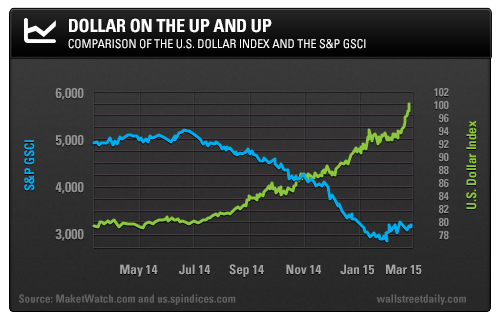Believe it or not, you can learn everything you need to know about trading commodities in an Economics 101 class.
It’s all about supply and demand.
So why is trading in this sector so difficult to master?
Because supply and demand are an aftereffect of the various events that dictate them in the first place.
Unpredictable factors like Mother Nature, geopolitical events, and changing regulations all affect the supply and demand of commodities.
However, there is one consistent force that investors can count on that drives the commodities markets in a predictable way. And these days it’s going up, up, up…
Forces of Nature, Politics, and People
The outside forces I mentioned above put an ongoing downward pressure on the commodities markets.
Mother Nature, for one, can influence both the supply and demand sides of the equation and move markets. For example, a warm weather snap reduces the demand for heating oil, and a late frost can reduce the supplies of many crops.
Political and regulatory influences like taxes, subsidies, tariffs, and other trade restrictions can cut off the supply of a commodity, or make it difficult to import or export. Just consider what the current restrictions on Russia are doing to the natural gas and wheat markets.
There are also macro forces like global interest rates, market liquidity, capital flows, and trade balances.
China, for example, reported a USD 60.6-billion trade surplus in February 2015 – compared with a USD 22.9-billion deficit a year earlier – as exports surged while imports dropped. And even though this particular statistic is largely an outcome, rather than a cause of price movements, its announcement alone can move commodity prices from a predictive standpoint.
And then there are micro forces, such as raw material substitutes, commodity sector consolidation from mergers and acquisitions, and labor issues like strikes or accidents – such as a mine explosion or oil spill.
Additionally, environmental pressures can have a major effect on both production and consumption. Imagine how much more crude oil and natural gas supply there would be if hydraulic fracking wasn’t opening the floodgates of debate throughout so many countries.
What tends to happen when any of these influences exert force, is that not only does the cash (spot) price of commodities move, but so can the entire shape of its forward curve.
The forward curve can whipsaw between contango and backwardation, sometimes rapidly. In some cases, the curve takes the shape of a roller coaster, particularly when seasonality is a factor. This is typical in natural gas, for example.
Even with all of these factors in play, however, there is one force that can influence commodity movements more than anything else…
I’m talking about the US Dollar
Staying U.S. Strong
Since commodities around the world are priced in the U.S. dollar, a strong currency in the United States is great for all commodity consumers around the world.
A strong dollar makes commodities less expensive to import, irrespective of where the commodity was produced.
Thus, in today’s strong USD market, we have what economists would call an efficient market. That is, cheap commodities and a strong dollar.

The good news for commodity importers around the world is that the dollar is likely to continue to strengthen in the short and medium term.
First, the United States completed its quantitative easing in October, and the economy is back on top again (relative to its trading partners).
In contrast, most of the rest of the world is in full-fledged stimulus mode.
Mario Draghi, President of the European Central Bank, began a USD 1.1-trillion program of bond purchases this week amidst high unemployment and the Greece overhang.
The Bank of China is loosening its policy as its economy is growing at the slowest rate in about 24 years. And markets are anticipating a third round of quantitative easing out of Japan.
Even emerging markets are in stimulus mode, such as Thailand and South Korea – both of which cut interest rates this week.
Second, with the U.S. stock market trading near record highs and robust U.S. employment numbers, fears of a federal interest rate hike are only pumping up the dollar more.
My plan is to stay in KISS mode and keep things simple: When we start to see the U.S. Dollar Index turn, that’s the signal to get back into commodities or reverse your commodity short.
And following with our simple theme, readers should explore trading with an index, which is an easier and more-diversified approach. Among the myriad of choices are some of the bigger broad-based indices, such as the Dow Jones Commodity Index (ETRACS DJ-UBS Commodity Index TR (NYSE:DJCI)) and the S&P GSCI Copper Source T-ETC (XETRA:SCOPP).
But watch out! A drop in the dollar could turn out to be a head fake… It’s better to scale into a trade than to jump in head first.
